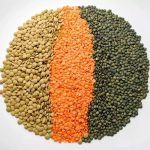 If you have less than perfect eyesight, you probably have, at this very moment, two lentils perched on either side of your nose—at least you do in so far as the English word lens is a direct adoption of the Latin word lens, meaning lentil. Lens was adopted by seventeenth century opticians because the convex shape of the lentil resembled that of the pieces of glass they cut to make telescopes and microscopes. The Latin lens is also, of course, the source of the English word lentil: in Late Latin the name of the leguminous plant was turned into a diminutive—lenticula, meaning little lentil—which was subsequently adopted by French as lentille. English then adopted this French word in the mid thirteenth century, changing the spelling to lentil in the process.
If you have less than perfect eyesight, you probably have, at this very moment, two lentils perched on either side of your nose—at least you do in so far as the English word lens is a direct adoption of the Latin word lens, meaning lentil. Lens was adopted by seventeenth century opticians because the convex shape of the lentil resembled that of the pieces of glass they cut to make telescopes and microscopes. The Latin lens is also, of course, the source of the English word lentil: in Late Latin the name of the leguminous plant was turned into a diminutive—lenticula, meaning little lentil—which was subsequently adopted by French as lentille. English then adopted this French word in the mid thirteenth century, changing the spelling to lentil in the process.
A diminutive and pale-colored legume that bears a resemblance to a flattened pea. Lentils are highly nutritious and affordable, and are commonly employed in Indian and European cuisine.
Lentils are a type of pulse vegetable that come from the seeds of leguminous plants. Roughly half the size of a pea, they possess a distinctive flavor. In the Orient, particularly in Egypt, lentils have been a dietary staple for countless centuries. Nowadays, they are grown all over southern Europe and in the United States. Three main lentil varieties are sold: Egyptian or red lentils, which are cultivated in Palestine, Arabia, and Egypt; European or yellow lentils, primarily grown in Germany and France; and German lentils, a type of European lentil that is dark green in color and believed to be more flavorsome than the yellowish-red variety.
